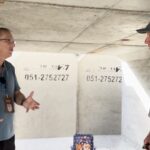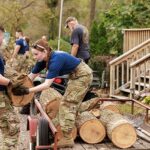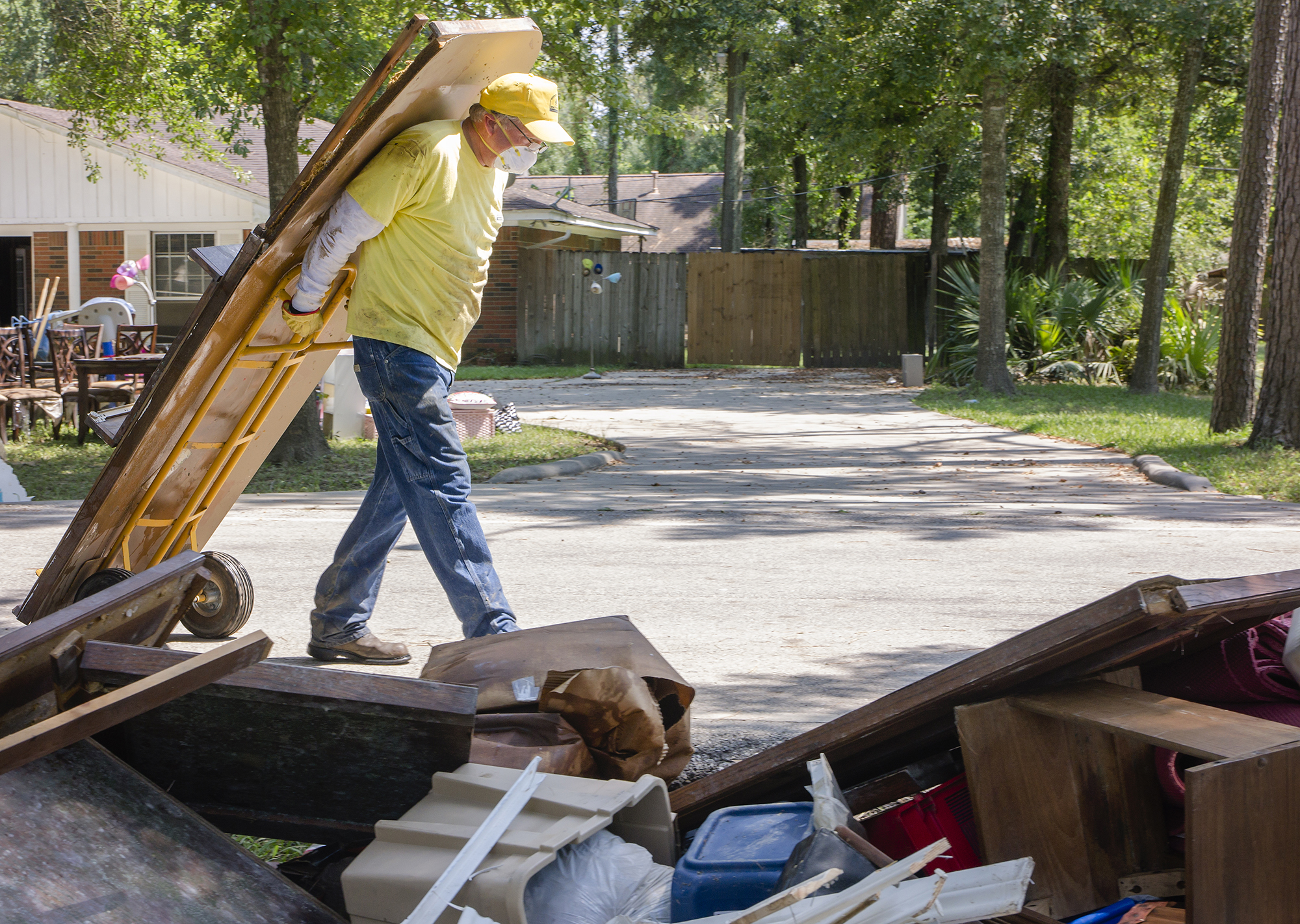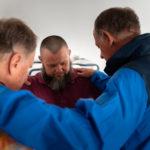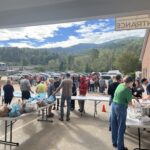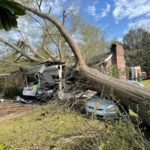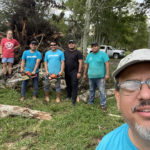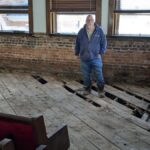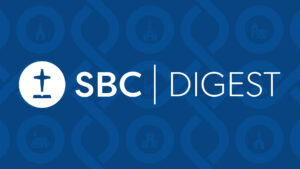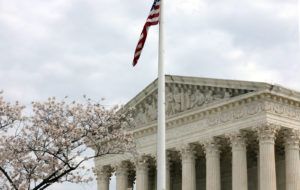
JACKSONVILLE, Fla. (BP) – Together. That’s how Florida Baptist Disaster Relief responds to disasters. In the aftermath of heartbreaking crisis, FBDR serves alongside numerous partners to deliver the hope of the Gospel to those who need it the most.
A pillar of strength and faith in the Sunshine State after disasters create a sense of hopelessness, FBDR volunteers do whatever it takes to help individuals in need. That might mean rising before dawn to start cooking and packing thousands of meals. Or it might mean slogging through mud to try to salvage what’s left in a devastated home. Or it might mean grasping a chainsaw and tackling a giant tree that has landed on a resident’s home.
It definitely means taking the hope of Christ to those desperate to hear a word of hope.
“We want to make sure that, first and foremost, that people know why we’re here, who we’re here to represent and why we’re doing what we do to bring them hope in the name of the Lord Jesus,” said David Coggins, FBDR director.
“That’s always forefront in all of our minds.”
Growing stronger through the years
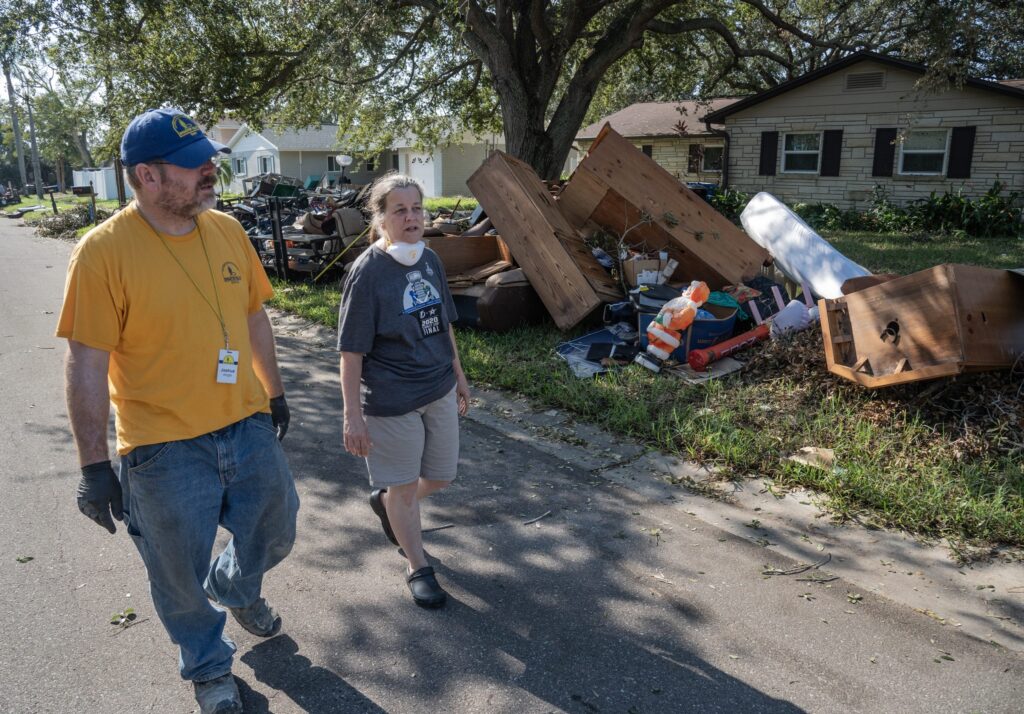
For more than 125 years, the Florida Baptist Convention has been responding in many ways to help individuals and churches recover from destructive hurricanes, starting with its first response in 1896 when an unnamed hurricane damaged 10 churches in the Florida Panhandle and the state convention provided funds for the churches to rebuild.
Over the next few decades, the Florida Baptist Convention actively responded as needed in recovery efforts following hurricanes. The convention adopted its first FBDR policy in 1972, revised the policy in 1976, held its first disaster relief training in 1978 and established a disaster relief and recovery department in 1982.
From that start, Florida was among nine state Baptist conventions in 1988 that officially joined with the growing network of the Southern Baptist Disaster Relief ministry, which had been launched in 1966. The SBDR, which began as a grassroots movement among Southern Baptists in the 1960s, has grown into one of the nation’s top three disaster relief organizations.
Through the years, Florida Baptist disaster response, particularly related to devastation from hurricanes, likewise has been refined and bolstered to become today’s robust FBDR that is prepared and ready to respond when needed.
Today, FBDR has 4,000 credentialed volunteers who are trained to serve in one of eight ministry areas: chaplaincy, logistics, onsite management, children’s crisis response, clean up and recovery, feeding, administration and communication. Because the scope of disaster relief has been expanded through the years, the timeframe of recovery efforts has also expanded. Sometimes, recovery efforts may stretch from months into years.
Disaster relief volunteers “stay as long as needed,” Coggins said.
But, FBDR does not work alone.
Partnership with other state conventions
As early as 1992, FBDR welcomed disaster relief teams from nine other state conventions in response to Hurricane Andrew’s vicious assault on South Florida. After Hurricane Ian pummeled Florida in 2022, disaster relief teams from at least 17 other state conventions rallied to help in recovery efforts.

This year, as three hurricanes made landfall in Florida, numerous state conventions have partnered with FBDR. Disaster relief teams from other Baptist state conventions, including New Mexico, Arizona, California and the Northwest, joined FBDR in Hurricane Helene relief efforts, working out of Westwood Baptist Church in Live Oak. Disaster relief teams from other Baptist state conventions, including Kentucky, Ohio, Louisiana, Texas and Mississippi, joined FBDR in Hurricane Milton hurricane relief response.
Recovery efforts are ongoing.
State convention-to-state convention cooperative relief efforts have strengthened with disaster after disaster wreaking havoc across the country, including wildfires, tornadoes and even the 9/11 terrorist attacks. Often, FBDR volunteers travel throughout the country and even international destinations to partner with other state convention disaster relief teams in recovery efforts.
Partnership with Send Relief
In 2016, Send Relief was launched by the North American Mission Board as an evangelistic compassion ministry effort to help churches reach North America. Then, in 2020, the International Mission Board and NAMB joined forces to create an international reach for Send Relief.
Just over two years ago, in February 2022, Send Relief and Southern Baptist Disaster Relief entered into a working partnership agreement to respond together in relief efforts. The partnership calls for Send Relief to provide recovery resources and food to support disaster relief in its ministries to disaster survivors.
Through this agreement, Send Relief can raise funds related to crisis response that will be used to replenish Send Relief’s disaster relief supplies, support national disaster projects and provide need-based crisis response grants. During major disaster events, Send Relief often establishes a fund specific to that response, and it shares those funds with the state disaster relief units that are directing the recovery response. On an ongoing basis, non-designated crisis response donations given to Send Relief are divided between international, North American and SBDR compassion ministries.
At the time of the agreement, Coy Webb, crisis response director for Send Relief, said, “I continue to believe that the Southern Baptist Disaster Relief network remains one of the greatest examples of the Cooperative Program at work. Send Relief is excited to partner in even greater ways and to mobilize these highly trained and gifted volunteers to respond globally to bring the compassion and hope of Christ to hurting people.”
Recently when Hurricane Milton was threatening landfall, Send Relief readied a tractor-trailer with more than 20,000 meals, bottled water, rolled roofing, water and generators in Georgia and then, as weather and travel conditions allowed, deployed the resources to southwest Florida in support of FBDR’s response.
Coggins expressed gratefulness for Send Relief’s partnership in recovery efforts.
“Send Relief is very encouraging and supportive of the work we are able to do,” he said. “When we are running short of resources, we know we can turn to them and find what we need to keep helping survivors and we don’t have to stop our work. We also know that Send Relief leaders are praying for us and always checking to see how we are doing and telling the story of what God is doing in bringing hope in the midst of all of the hurt.”
Following Hurricane Milton’s landfall, Send Relief President Bryant Wright visited Florida, prayed with pastors leading their churches in the storm’s aftermath, helped serve meals to community residents, and shared the hope of the Gospel with those in despair. Wright also experienced firsthand the unity of SBDR and Send Relief in recovery efforts.
“The way Southern Baptist Disaster Relief and Send Relief come together to serve in the aftermath of crises is a beautiful picture of the kingdom of God,” Wright said. “Disaster relief teams are the boots on the ground, while Send Relief coordinates nationally and provides material and financial resources that fuel their efforts.”
Other partnerships
FBDR works alongside other non-Southern Baptist partners also, including state and federal agencies, The Salvation Army, American Red Cross and first responders.
During the Hurricane Debby response in August of this year, FBDR and The Salvation Army launched a joint service initiative, which had been made possible through SBDR efforts, to ensure that every Salvation Army mobile feeding unit would be accompanied by trained chaplains to offer the hope of the Gospel to those impacted by disaster.
When the initiative was launched, Coggins said, “Jesus gave us a mandate to meet the physical needs of people, but more so He gave us a mandate to meet the spiritual needs.”
That partnership approach from the two faith-based relief organizations to meet both physical and spiritual needs will be a continued focus and priority moving forward in recovery from future disasters.
Looking ahead
In the years ahead, as disasters continue to occur, FBDR and its partners will be there to respond and share the hope of the Gospel.
“We value the working relationships with all of our partners,” Coggins said. “We do not have all the resources necessary to do all that we need to do. We are grateful that God gives us many partners that walk alongside us and that we are able to walk alongside when we are called upon also. We are especially grateful for our churches that we get to come beside and walk with them in ministry to their communities and provide the resources they need to minister in those communities.
“God has given us a large task to reach the hurting people impacted by these events, and we need each other to meet the challenges that lie before us in bringing the hope of the Gospel to those impacted.”
This article originally appeared at flbaptist.org.


